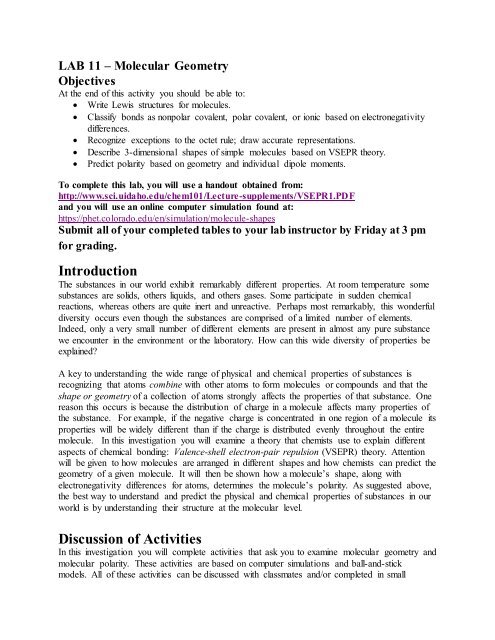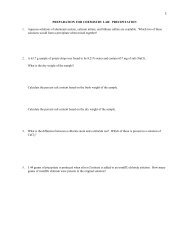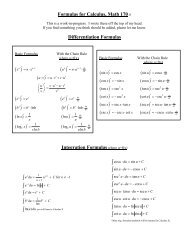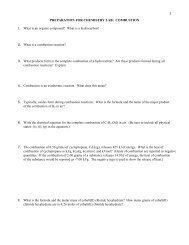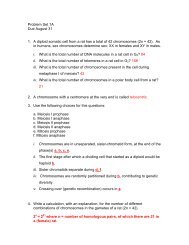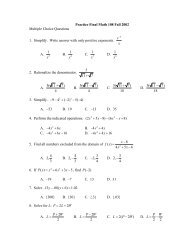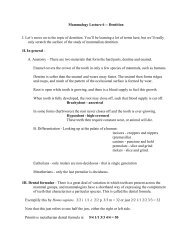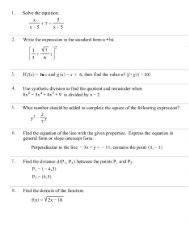LAB 11 Molecular Geometry Objectives
LAB 11 Molecular Geometry Objectives
LAB 11 Molecular Geometry Objectives
Create successful ePaper yourself
Turn your PDF publications into a flip-book with our unique Google optimized e-Paper software.
<strong>LAB</strong> <strong>11</strong> – <strong>Molecular</strong> <strong>Geometry</strong><br />
<strong>Objectives</strong><br />
At the end of this activity you should be able to:<br />
Write Lewis structures for molecules.<br />
Classify bonds as nonpolar covalent, polar covalent, or ionic based on electronegativity<br />
differences.<br />
Recognize exceptions to the octet rule; draw accurate representations.<br />
Describe 3-dimensional shapes of simple molecules based on VSEPR theory.<br />
Predict polarity based on geometry and individual dipole moments.<br />
To complete this lab, you will use a handout obtained from:<br />
http://www.sci.uidaho.edu/chem101/Lecture-supplements/VSEPR1.PDF<br />
and you will use an online computer simulation found at:<br />
https://phet.colorado.edu/en/simulation/molecule-shapes<br />
Submit all of your completed tables to your lab instructor by Friday at 3 pm<br />
for grading.<br />
Introduction<br />
The substances in our world exhibit remarkably different properties. At room temperature some<br />
substances are solids, others liquids, and others gases. Some participate in sudden chemical<br />
reactions, whereas others are quite inert and unreactive. Perhaps most remarkably, this wonderful<br />
diversity occurs even though the substances are comprised of a limited number of elements.<br />
Indeed, only a very small number of different elements are present in almost any pure substance<br />
we encounter in the environment or the laboratory. How can this wide diversity of properties be<br />
explained<br />
A key to understanding the wide range of physical and chemical properties of substances is<br />
recognizing that atoms combine with other atoms to form molecules or compounds and that the<br />
shape or geometry of a collection of atoms strongly affects the properties of that substance. One<br />
reason this occurs is because the distribution of charge in a molecule affects many properties of<br />
the substance. For example, if the negative charge is concentrated in one region of a molecule its<br />
properties will be widely different than if the charge is distributed evenly throughout the entire<br />
molecule. In this investigation you will examine a theory that chemists use to explain different<br />
aspects of chemical bonding: Valence-shell electron-pair repulsion (VSEPR) theory. Attention<br />
will be given to how molecules are arranged in different shapes and how chemists can predict the<br />
geometry of a given molecule. It will then be shown how a molecule’s shape, along with<br />
electronegativity differences for atoms, determines the molecule’s polarity. As suggested above,<br />
the best way to understand and predict the physical and chemical properties of substances in our<br />
world is by understanding their structure at the molecular level.<br />
Discussion of Activities<br />
In this investigation you will complete activities that ask you to examine molecular geometry and<br />
molecular polarity. These activities are based on computer simulations and ball-and-stick<br />
models. All of these activities can be discussed with classmates and/or completed in small
groups. The VSEPR model can be used to predict the geometry of molecules and polyatomic<br />
ions. <strong>Molecular</strong> geometry describes the positions of the nuclei in relation to each other. Included<br />
in the description are the bond angles, the angles made by the lines joining the nuclei of bonded<br />
atoms. In order to predict geometry using the VSEPR model, we need to know the number of<br />
electron pairs in the valence shell of the central atom. That can easily be determined by drawing<br />
a Lewis structure.
Activity 1: Drawing Lewis Structures
Activity 2: VSEPR and Predicting <strong>Molecular</strong> <strong>Geometry</strong><br />
Once we have the Lewis structure, we have the information needed to predict the geometry. It’s<br />
important to remember that what we really want to know is the molecular geometry—the<br />
positions of the nuclei in relation to each other. The molecular geometry is dependent on the<br />
electron domain geometry; that is why the initial step is drawing the appropriate Lewis structure!<br />
As noted above, the simple concept behind valence shell electron pair repulsion theory (VSEPR)<br />
is the idea that electron pairs in the valence shell of an atom will repel each other and arrange<br />
themselves as far apart as possible. This arrangement of electron pairs will determine the<br />
geometry of the molecule or polyatomic ion. To help you make predictions, use the VSEPR<br />
handout and the PHET simulation. You may also search the web for structures. You will be<br />
given the handout on your final exam.<br />
Your initial task in this activity is to determine the molecule geometry as the number of electron<br />
pairs changes. Accomplish this by using the computer simulation “Molecule<br />
Shapes” (shown above) (https://phet.colorado.edu/en/simulation/molecule-shapes) and the<br />
VSEPR handout (http://www.sci.uidaho.edu/chem101/Lecture-supplements/VSEPR1.PDF)<br />
and fill in the table. Notice, in this simulation you can increase the number of electron domains<br />
by adding single, double, or triple bonds, or lone pair electrons. In the lower left corner you will<br />
find both the molecule geometry and the electron geometry.
The molecular geometry is the same as the electron domain geometry if all domains contain<br />
bonding pairs. What if lone pair electrons are present on the central atom The molecular<br />
geometry will NOT be the same as the electron domain geometry. To investigate this, return to<br />
the simulation and complete Table 3. If you do not understand the names for the different<br />
geometries consult the handout.
In the last table, you are asked also to determine molecule polarity. Read or review section 9-9<br />
and the Summary Chart on page 309 of your textbook.
Putting it all together…<br />
Being able to predict the polarity of a molecule is extremely important since many properties of<br />
molecules depend on whether they are polar or non-polar. As you have seen in this activity,<br />
determining a molecule’s polarity is a multi-step process:<br />
Draw Lewis Structure<br />
Use VSEPR to determine molecular geometry<br />
Determine bond polarity (based on electronegativity differences)<br />
Determine molecular polarity based on bond dipoles & molecular geometry


